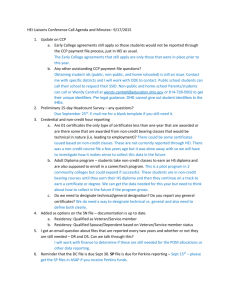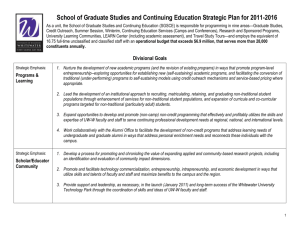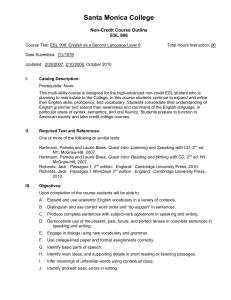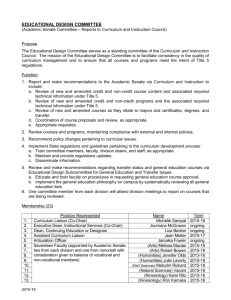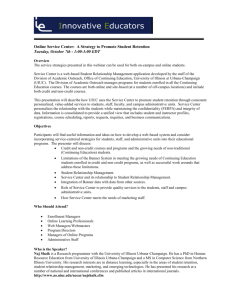NISTGRANTPROJECT SUMMARY
advertisement
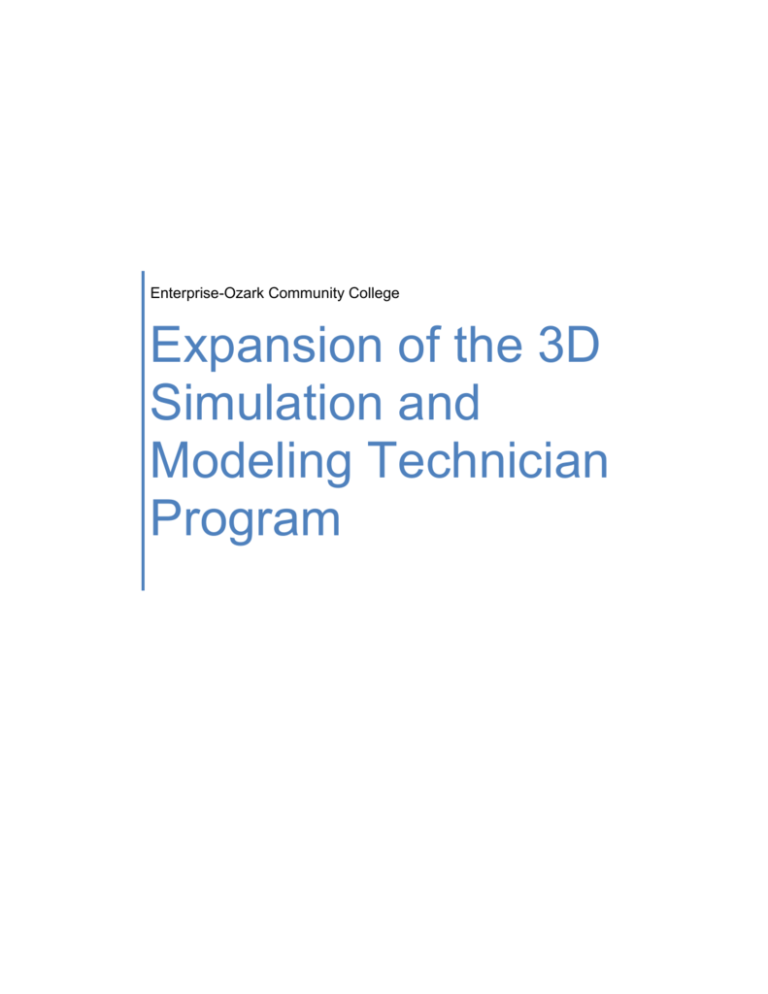
Enterprise-Ozark Community College Expansion of the 3D Simulation and Modeling Technician Program Project Title: Expansion of 3D Simulation and Modeling Technician (3D SMT) Short Term Certificate Program Amount of Funds Requested: $ 1,084,208 Service Provider/Fiscal Agent: Enterprise-Ozark Community College Mailing Address: PO Box 1300, Enterprise, AL 36331 Name of Project Contact: Dr. Jean Johnson Title: Chairperson, Division of Fine Arts; Distance Learning Coordinator FAX: (334) 393-6223 I. Email: jjohnson@eocc.edu Phone: (334) 347-2623 x 2316 Authorization As the person authorized to act on behalf of the service provider/fiscal agent, I certify that the information submitted in this proposal is accurate. I also certify that the service provider will carry out the proposed activities as stated and will follow accountability and reporting requirements. Nancy W. Chandler Printed or Typed Name -Authorized Official President Title Signature of Authorized Official Date TECHNICAL PROPOSAL SUMMARY I. Project title: Expansion of 3D Simulation and Modeling Technician (3D SMT) Short Term Certificate Program II. Service provider/fiscal agent: III. Total funds requested: IV. Project start and end dates: September 1, 2009 – August 31, 2010 V. Statement of need or priorities to be addressed by proposed activities: Enterprise-Ozark Community College $1,084,208.00 Enterprise-Ozark Community College (EOCC) is the only community college in southeast Alabama offering training in the development of three-dimensional objects and environments needed by a wide variety of educational settings, businesses and industries. Currently, EOCC has funding to purchase only ten computer stations to be used in the 3D Simulation and Modeling Technician Short Term Certificate Program, which severely hampers the College’s ability to provide the modeling technicians needed in this growing occupation. We see the benefit of state-of-the-art computational measurement techniques in 3D modeling and simulation, and we are committed to ensuring that the highest levels of accuracy and performance are achieved. In the area of information technology/cybersecurity, we propose to address subtopic 4: research enabling fundamental advances in computational science and engineering associated with measurement and standards in visual data analysis. We also will address subtopic 7: research to develop advanced image analysis techniques and tools relevant to measurement science. Our faculty members working on this project are educated to the level of master’s degree or doctorate in their fields and many years of experience in computer science. VI. Proposed activities: The College will expand its ability to train 3D Simulation and Modeling Technicians by purchasing additional computer stations for the laboratory located at the Enterprise Campus, establishing a laboratory at the Fort Rucker Site, and by creating non-credit offerings in 3D SMT for existing businesses and industries. VII. Anticipated outcomes (include target level of performance for each outcome): 1. 50 students will be enrolled in the credit offerings at the Enterprise Campus and Fort Rucker Site 2. 10 students will be enrolled in non-credit offerings 3. 75% of students in credit / non-credit programs will complete the course of study 4. 80% of completers in the credit program will be placed in related employment VIII. Performance measures: 1. 60 students will be enrolled in credit and/or non-credit offerings by the end of the 2009-2010 Academic Year 2. 45 students in credit or non-credit programs will complete the course of study by the end of Fall Semester 2010 3. 80% of students who complete the credit course of study will be placed in related employment within two semesters of program completion 4. Program will self-sustain with 40 seats per semester, three semesters per year. PROJECT BUDGET Budget Item Salary Benefits Staff Development/Training Travel In State Travel Out of State Public Relations Materials/Supplies TOTAL Cost Total 165,150 50,732 165,150 50,732 4,500 4,500 950 3,050 25,500 834,326 950 3,050 25,500 834,326 $ 1,084,208 $ 1,084,208 PROJECT BUDGET NARRATIVE I. $165,150: Program Staff Salaries (Position title/function of staff assigned to projectspecific program services activities, salary/wage, percentage of time charged to project.) 2 full-time instructors: Salary Schedule 1A-D-1, Step 5 = $58,575 x 2 = $117,150 3 part-time instructors @ $1,600 per 3 hour class x 10 classes = $48,000 II. $50,732: Program Staff Benefits (Type and cost of fringe benefits for each position included in project budget.) FICA Matching (7.65%); Unemployment compensation (.07%); Retirement Matching (12.07%); PEEHIP @ $9,024 annually 2 full-time instructors = $41,232 FICA = $8,962 Unemployment = $82 Retirement = $14,140 3 part-time instructors = $9,500 FICA = $3,672 Unemployment = $34 III. PEEHIP = $18,048 Retirement = $5,794 PEEHIP = NA Individual Training (Fees or other training fees; tuition; training materials and other costs related to training of individuals.) Not applicable IV. $4,500: Staff Development/Training (Detail of consultants; tuition/fees, other costs related to providing and/or attending.) ArcView and GIS software training: $750/course x 3 courses = $2,250 Auto Desk 3D MAX software training: $750 /course x 3 courses = $2,250 V. Employer Outreach and Services (Details of outreach activities; other similar employer services.) Not applicable VI. $4,000: Travel (Costs of mileage, lodging, meals and other travel-related costs.) Instate Travel = $950 3 persons travel to Birmingham, AL for training programs 3 days @ $75 per diem x 3 travelers = $675 Mileage to Birmingham: 500 miles @ $0.55 /mile = $275 Out of State Travel = $3,050 3 persons travel to Fayetteville Technical Community College, Fayetteville, NC to visit the 3D Simulation and Modeling Technician program, Visual Learning Lab, and Experience and Discovery Lab Airfare: 3 travelers @ $750 roundtrip = $2,250 Meals for two days @ $50 per person x 3 = $300 Hotel: 2 nights @ $125 / night x 2 rooms = $500 VII. $25,500: Outreach, Public Relations (Details of media advertising and other public outreach costs, e.g., newspapers, radio/TV, direct mail, etc.) Radio Advertising [21 thirty-second spots (14 stations)]: $6,000 8 Newspapers: [two 4-column x 4” ads (11 publications)]: $4,000 Billboards: (number TBD): $4,000 Television: (1 station): $500 production cost + $5,000 to air commercial = $5,500 Brochures: (distributable institutional materials): $6,000 VIII. $834,326: Materials & Supplies (Office supplies, training supplies, other supplies required to carry out project, detailed by type costs.) Visual Learning Labs at Enterprise Campus and Fort Rucker Site for teaching students to create 3D objects and environments SMT Integrated Enterprise Learning Suite consisting of lab computers and software listed below 30 lab computers w/ cabling @ $3,500 each 30 Computer Stations consisting of Recessed Monitor Tables and Contoured Task Chairs @ $1,053 each Installation, testing and integration 5 Instructor computers @ $3,500 each 35 licenses of the following software: 3D Studio Max software @ $395 each Unity Pro @ $1,500 each Unity Asset Server license @ $500 each ArcView/ArcGIS @ $245 each Autodesk AutoCAD Inventor Professional @ $1,435 each 37 licenses of Immersive Real Time Software Development Suite (35 for lab & instructor computers, 1 each for 3D Projection and 3D Wall) @ $5,500 each 3D Wall consisting of 3D configured projector Stereo filters Computer platform Wireless Wand and Keyboard DVI Extenders / Cabling 16:9 Wide Aspect Screen & Motor 3 days installation, testing and integration Mobile 3D Visual Learning Lab 105,000 31,590 250 17,500 13,825 52,500 17,500 8,575 50,225 203,500 75,007 19,777 Experience and Discovery Lab for use of objects and environments in educational programs, training for workforce development, etc. 3D Theater Projection System consisting of Theater Quality Passive Stereo Projectors Specialized color wheel lens Dolby 7.2 Surround Theater System Stereo integration rack Stereo glasses Wireless Wand and Keyboard VR authoring tool for real-time photo realistic features, advanced physics engine, CAD integration and realistic human behaviors DVI Extenders/cabling/ NVidia Quadro Plex with Casing System and Mounts 16:9 Wide Aspect Screen and 16:9 Wide Aspect Screen Motor 5 days installation, testing and integration Integrated AMX Solution consisting of Computer platform AMX 17’ Monitor Cabling / Extenders and conduit Rack system with Cabling Installation, testing and integration Integrated Touch and TelePresence Technology consisting of Computer platform Touch Interaction Display Screen with Integrated Projection System for Compact foot Print with TelePresence HoloPodium for Virtual Presenter DVI Extenders for Integration Video Capture Board, Digital Still Camera, Custom Mounting and Cables Installation, testing and integration 128,177 34,695 76,205 TECHNICAL PROPOSAL I. Statement of Need This project proposes to expand EOCC’s capacity to teach students to develop interactive three-dimensional (3D) objects and environments that can satisfy workforce development, industry and government needs for a wide variety of situations, including training programs, educational settings, and entertainment venues. Increasing the capacity of the College’s 3DSimulation and Modeling Technician (3D SMT) Short Term Certificate program will offer more opportunities to train graduates to develop and manipulate virtual objects within a three dimensional space. The importance of developing such virtual reality objects can best be shown in some examples. For instance, using 3D objects created by graduates of this program, flight engineers may have access to virtual reality models of equipment and could view performance in highly accurate simulations of real-world environment. Entertainment venues may develop accurate, scaled environments to showcase new attractions or even develop audience-immersive experiences. Emergency Medical Services personnel may use 3D objects to learn proper techniques for cardiopulmonary resuscitation (CPR) or to evaluate emergency situations. Given the time and expense involved in the creation and utilization of traditional models and simulations, the ability to develop virtual reality, 3D objects and environments allows for rapid design and reconfiguration at relatively low cost and effort. Given the presence of both the U.S. Army and defense contractors within Region 10 and, in particular, EOCC’s service area, the need for training 3D simulation technologists is increasing, as their skills allow for the creation of a wide variety of objects and environments of value to these industries, thereby reducing the need for traditional cost- and labor-intensive efforts that result in products of limited use. Currently EOCC is purchasing hardware and software to teach only ten students at a time on the Enterprise Campus. Funding for this expansion project will increase the capacity by installing ten more computer stations at the Enterprise Campus, by installing a 20-computer station laboratory at the Fort Rucker Site, and by providing the training through non-credit as well as for-credit offerings. According to 2005 data provided by the U.S. Department of Labor’s O*Net website, growth in the field of multi-media, which comprises 3D simulation, is projected to occur at a rate of 26%, a much faster rate compared with other occupations. The website data also projects that an additional 43,000 employees shall be required by 2016 to provide expertise in the field of multi-media. In the United States, the median annual salary is $54,600; the annual median wage in Alabama is $45,100. The Bureau of Labor Statistics website www.bls.gov/oes/2008/may/oes271014.htm#ind lists the top paying industries for this occupation in the following chart. Industry Employment Hourly mean wage Annual mean wage Other Information Services 1,030 $36.59 $76,110 Motion Picture and Video Industries 9,050 $34.57 $71,910 Specialized Design Services 1,900 $34.03 $70,770 Aerospace Product and Parts Manufacturing 70 $33.78 $70,270 Employment Services 340 $32.79 $68,200 Using data for the United States is important in this field because graduates of the 3D Simulation and Modeling Technician program will be qualified to operate home-based businesses, located in Region 10, that contract with businesses, industries, and entertainment and education providers throughout the United States. The objects and environments created will be sent to the contractor via simple media (compact or digital video disks, flash drives, etc.), electronic mail, or networked computer systems. The ability to operate as an independent contractor / small business owner makes this program enticing to such prospective students as disabled American veterans and military family members. Simply stated, funding of the proposed project would allow for the expansion of the College’s capacity to offer the Short Term Certificate program in 3D-SMT to train the modeling/simulation technologists required to meet local demand. The strengths of this program, which benefits both students and employers, are many and include the small length of time required for training -- allowing the majority of students to complete the program within two semesters. This shall ensure a steady stream of trained professionals to meet growing demand. II. Project Activities Time October 2009 Activity Appoint Project Advisory Committee comprised of representatives from business, industry, and education to provide advice to the Program Development Team (PDT)1 and to evaluate project activities and outcomes Purchase and install computer hardware, software, peripherals in labs located at Fort Rucker Site and Enterprise Campus Develop/implement marketing/recruiting plan Hire full-time faculty Identify adjuncts Review syllabi and competencies Schedule Classes for Spring Semester 2010 Create 3D objects for training programs January 2010 February March April April-May June-August 1 Admit/Register students for classes Coordinate with businesses and industries to identify needs for customized/specialized training 25 Students begin credit courses Recruit students for summer semester Evaluate progress of project Schedule Classes for Spring Semester 2010 Provide workshop on creating 3D objects to representatives of business, industries, and education Evaluate progress of project Develop customized, non-credit training for workshop participants and others Offer customized, non-credit training to 10 students Responsible Party EOCC President Project Director Public Relations Director Project Director College Recruiters President Dean of Instruction Project Director Dean of Instruction Project Director Faculty Project Director Division Chairs Project Director Faculty Admissions/Registrar TEBI Coordinator Recruiters Public Relations Director PDT Project Director Division Chairs TEBI Coordinator Faculty PDT TEBI Coordinator TEBI Coordinator Program Development Team: Dr. Jean Johnson, 3D SMT Project Director and Chairperson of the Division of Fine Arts (Chair); Dr. Judy Miller, Dean of Instruction; Dr. Wanda Flowers, Chairperson of Computer and Information Science Division and Business Division; Ms. Susan Steck, Associate Dean of Institutional Advancement; Mr. Carl Holbrook, Coordinator of Training for Existing Business and Industry Time June August III. Activity 25 Students begin credit courses Evaluate progress of project Responsible Party Faculty PDT Individuals and Industries Served Enterprise-Ozark Community College will focus recruiting efforts to on the following target groups. Recent high school graduates who have demonstrated a high interest in technology and have stated a desire to receive specialized training leading to high-wage employment in this field. Employees desiring career transitioning due to unemployment or underemployment. Military service personnel and family members -- active duty U.S. Army personnel returning home to the EOCC service area preparing for separation from the service under the auspices of the Fort Rucker Warrior Transition Unit; military family members (i.e. spouses, children, and other dependents) seeking transportable careers; disabled American veterans. Employers of local existing businesses and industries seeking to use 3D objects and environments in their training programs. The sixteen-week short-term training program allows more immediate entry into the workforce. The training program is unique to this area and provides students with highly specialized, but broadly adaptable and transferable, technical training in the development and manipulation of advanced 3D virtual simulations of objects and environments. The program of study is comprised of the following one-course modules. Advanced Visualization: The successful completion of this module provides students the ability to use advanced image editing and three-dimensional graphics software to create photorealistic, animated virtual simulations. Environment Programming: The ability to develop object-oriented, three dimensional environments is the goal of this module, which involves instruction in a general purpose programming language. Mastery of this module’s competencies allows users to build graphics-intensive applications. CAD (Computer-Assisted Design): Successful completion of this module, which focuses on computer-assisted design and drafting, allows students to render complex objects in two and three dimensions, a necessary prerequisite for the development of advanced simulations and modeling. GIS (Geographic Information Systems): Instruction in this module is focused on the successful analysis and management of data necessary for the construction, manipulation, and the real-time presentation of geographic information. Students shall demonstrate their mastery of the concepts and skills obtained in the classroom through the completion of a Capstone Project. The project, which is intended to serve as the cornerstone of each student’s portfolio, shall be conducted in collaboration between the program and industry representatives. The successful completion of the project shall result in the development of a custom-designed, simulated object or environment intended to meet the needs of the sponsoring industry representative. The valuable experience and exposure gained by students in completing this project shall enhance their employability. The following business and industries have provided letters of support to this project. Business/Industry Name Type Sector Alfab, Inc. Metal Fabricator Manufacturing Army Fleet Support, LLC Aircraft Maintenance Aerospace/Aviation CATI Training Systems Training Technology; Aviation NavTech, LLC Training Technology Ronnie Gilley Properties, Inc. Entertainment Entertainment The primary benefit to companies listed above will be the creation of three-dimensional objects that are specific to their business or industry. The College’s Coordinator of Training for Existing Business and Industry (TEBI) and the Project Director will collaborate with the above companies, and identify others, to develop the Capstone Projects previously referenced. Creating these virtual objects and environments is an emerging occupation in the College’s service area. However, all of the companies who have given their written support to this project have also agreed to consider employment opportunities for graduates of the program. The TEBI Coordinator will develop new partnerships for job placement as the progress of the project leads to a repository of objects and environments that can be easily reconfigured to meet the needs of other employers. IV. Project Goals, Outcomes, and Performance Measures Goals 1. The 3D SMT Short Term Certificate program will be offered as the Fort Rucker Site. Outcomes Performance Measures 1. 50 students will be enrolled in the credit offerings at the Enterprise Campus and Fort Rucker Site 1. 60 students will be enrolled in credit and/or non-credit offerings by the end of the 2009-2010 Academic Year Goals Outcomes Performance Measures 2. The capacity to enroll credit students at the Enterprise Campus will be expanded. 2. 10 students will be enrolled in non-credit offerings 3. The program will be adapted for non-credit students. 3. 75% of students in credit / non-credit programs will complete the course of study 2. 45 students in credit or non-credit programs will complete the course of study by the end of Fall Semester 2010 3. 40 students who complete the credit course of study will be placed in related employment within two semesters of program completion 4. 80% of completers in the credit program will be placed in related employment Formative evaluation of the project will be conducted during the quarterly meetings of the Program Development Team and will assist in forming the project and its various programmatic efforts with necessary changes as it moves to its conclusion. Formative evaluations will allow for adjustment of schedules, revising of tasks, and revised managerial decisions, based on preliminary evaluation results. Such regular evaluation by the Team will ensure that the project goals have lead to the measured outcomes. V. Non-duplication Enterprise-Ozark Community College is the only two-year or four-year institution is southeast Alabama offering the 3D SMT Short Term Certificate. VI. Collaboration In the development of this expansion project, the College has worked with the aforementioned businesses and industries to locate prospective employment and non-credit training opportunities and has also sought advice and assistance from other stakeholders. For example, Enterprise CareerLink (a division of Alabama’s Career Cent System), the 4th District of the Disabled American Veterans, and Enterprise High School have agreed to assist in recruiting students for this program. Also, the City of Enterprise is planning to install three-dimensional display equipment in its office to exhibit a 3D model of the city to prospective businesses and industries and to potential residents. This 3D model could be a Capstone Project. Other stakeholders not previously mentioned who have assisted in the planning of this project include the following. VII. The Enterprise Coffee Geneva Economic Development Corporation has identified workforce partners for the project. Troy University has suggested collaboration between their faculty and that of EOCC to develop and share a repository of learning objects. Enterprise High School has identified a non-credit training opportunity for high school teachers to learn how to create objects for use in their curriculum. CATI Training Systems has identified employees who may be qualified to teach some of the courses in the program, and they have offered to establish an internship program so that graduates can get more real-world experience. NavTech, LLC has identified employees who may be qualified to teach the Capstone Project. The Chairman of the Region 10 Workforce Development Council and the Associate Director of Business and Education Services for the Governor’s Office of Workforce Development have both attended demonstrations on the creation of threedimensional objects and have offered advice on the development of this project. Leveraged Resources Enterprise-Ozark Community College will leverage resources in the form of facilities, recruiters (5% time of annual salaries = $5,246), the development of a marketing plan (Public Relations Director: 10 hours / semester = $626), and the Project Director’s time (10% of annual salary = $6,311). NavTech, LLC has donated to the College for use in this project a Mobile Visual Learning Lab® valued at $19,777. CATI Training Systems is working with a vendor to get the software, valued at $30,000 per license, donated or offered at a reduced rate. VIII. Sustainability Because of the partnerships with businesses, industries, service providers and other educational institutions created in the development of this project, EOCC will be able to sustain the project by recruiting students into the program and establishing non-credit offerings. IX. Capacity of Service Provider The College has been awarded and successfully implemented government grants in the past, including a $1.75 million five-year US Department of Education (USDE) Title III Strengthening Institutions project with three activities aimed at curriculum development, professional development, library automation, and student services development. EOCC administrators successfully administered budgets; implemented assessment and evaluation of project objectives; recommended employees for hire in the project; maintained open communication between project staff and other college faculty, staff and administration; ensured consistent and complete adherence to all federal, state, and institutional policies; monitored congruence of project objectives with college priorities and goals; prepared and disseminated project reports; and implemented and supported efforts to integrate project activities into regular institutional operations. November 1994 – 1997: EOCC administrators, faculty and staff members planned, implemented, and evaluated a three-year workplace literary project funded by the USDE National Workplace Literacy Program that combined educational resources of seven two-year colleges, two adult education programs, four textile and apparel manufacturing industries, and four trade associations. The project met or exceeded all eighteen objectives and served more than 1,000 employees annually in twelve locations in Alabama, South Carolina, and Georgia. EOCC administrators, faculty and staff ensured implementation of all phases of the project including needs assessment, curriculum development, instruction, creation of interactive software program, and evaluation activities. Fall quarter of 1978, Enterprise State Junior College, which became Enterprise-Ozark Community College in 2003, began a Student Support Services TRIO Program. The current grant scheduled to end in August 2010 will complete 32 years of continuous service to our students. The longevity of repeated funding from the United States Department of Education is a sound testimony of the ongoing success of our department--which is really a measure of success of our students. The Student Support Services (SSS) Program provides opportunities for academic development, assists students with basic college requirements, and offers services to motivate students toward the successful completion of their postsecondary education. The goal of SSS is to increase the college retention and graduation rates of its participants and facilitate the process of transition from one level of higher education to the next. Services available to eligible students include: career counseling, academic advisement, tutoring, financial aid information/assistance, transfer information, referrals to area agencies, escorted visits to senior universities and self-improvement workshops, diagnostic inventories, and cultural awareness activities. X. Special Characteristics of the Project Measurement science takes on a new dimension in the world of 3D models. In the area of information technology/cybersecurity, the expanded 3D simulation and modeling technician project proposed by this college would provide invaluable research and a skilled workforce (graduates of our program) to develop and use advanced 3D image analysis techniques. Medicine and health information technology are among the many areas for which image-based information management and retrieval will become invaluable. In addition, 3D computations will aid in analysis of environmental conditions that may be applied to energy conservation and management. A learning object repository will be created to store 3D objects developed by our faculty and students. These objects then will be available for sharing with other institutions of higher learning, as well as the business and industry community in what will become an ideal business-industry-college partnership. This partnership will serve the greater good of the community, the region, the state, and the nation. APPENDIX Administrators Assigned to this Project Dr. Judith G. Miller, Dean of Instruction B.S., Radford University M.S., Troy State University Ed.S., Troy State University Ed.D., Vanderbilt University Ms. Susan Steck, Director of Development B.S., Campbell University Ed.M., Boston University Additional Graduate Study Faculty Members Assigned to this Project Dr. Jean Johnson, Fine Arts Division Chair and Distance Learning Coordinator B.A., University of North Alabama M.M., University of Alabama D.M.A., University of Alabama Dr. Wanda Flowers, Business and Computer Information Science Division Chair A.S., Enterprise State Junior College B.S., Troy State University M.B.A., Troy State University Ed.D., University of Alabama Professional Staff Member Assigned to this Project Mr. Carlton Holbrook, Extended Programs Director and Training for Existing Business and Industry Director A.A., Enterprise State Junior College B.S., Troy State University - Dothan

